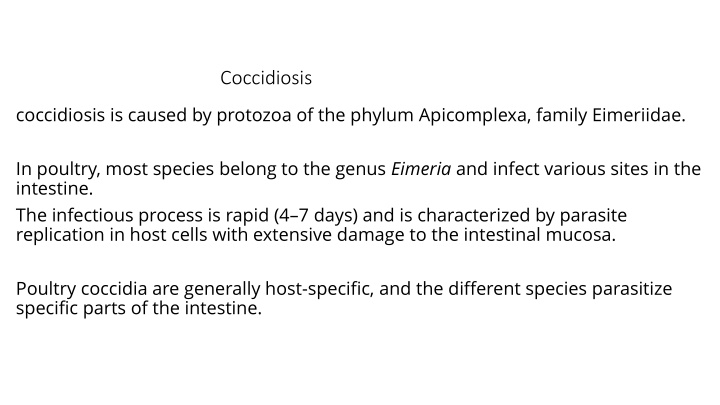
Coccidiosis in Poultry: Symptoms, Transmission, and Prevention
Learn all about coccidiosis in poultry, a disease caused by protozoa that infect the intestine. Discover the etiology, clinical signs, and postmortem lesions associated with this common issue. Find out how coccidia spread, the species affecting chickens, and crucial preventive measures. Educate yourself on the rapid infectious process, host-specificity, and impact on bird health.
Download Presentation

Please find below an Image/Link to download the presentation.
The content on the website is provided AS IS for your information and personal use only. It may not be sold, licensed, or shared on other websites without obtaining consent from the author. If you encounter any issues during the download, it is possible that the publisher has removed the file from their server.
You are allowed to download the files provided on this website for personal or commercial use, subject to the condition that they are used lawfully. All files are the property of their respective owners.
The content on the website is provided AS IS for your information and personal use only. It may not be sold, licensed, or shared on other websites without obtaining consent from the author.
E N D
Presentation Transcript
Coccidiosis coccidiosis is caused by protozoa of the phylum Apicomplexa, family Eimeriidae. In poultry, most species belong to the genus Eimeria and infect various sites in the intestine. The infectious process is rapid (4 7 days) and is characterized by parasite replication in host cells with extensive damage to the intestinal mucosa. Poultry coccidia are generally host-specific, and the different species parasitize specific parts of the intestine.
Etiology: Coccidia are almost universally present in poultry-raising operations, but clinical disease occurs only after ingestion of relatively large numbers of sporulated oocysts by susceptible birds. Both clinically infected and recovered birds shed oocysts in their droppings, which contaminate feed, dust, water, litter, and soil. Oocysts may be transmitted by mechanical carriers (eg, equipment, clothing, insects, farm workers, and other animals). Fresh oocysts are not infective until they sporulate; under optimal conditions [21 32 C] with adequate moisture and oxygen), this requires 1 2 days
Coccidiosis in poultry. Coccidiosis is a disease caused by a protozoan parasite of the genus Eimeria. There are seven species that cause disease in chickens: E. tenella, E. acervulina, E. brunetti, E. maxima, E. mitis, E. necatrix and E. praecox. Pathogenicity is influenced by host genetics, nutritional factors, concurrent diseases, age of the host, and species of the coccidium. Eimeria necatrix and Eimeria tenella are the most pathogenic in chickens, because schizogony occurs in the lamina propria and crypts of Lieberk hn of the small intestine and ceca, respectively, and causes extensive hemorrhage
Transmission and Spread Coccidia spread from an infected chicken to other chickens via oocysts. These oocysts are thick-walled structures which are passed out in the feces (droppings). Oocysts become infective (sporulated) after a few days and may survive for long periods depending on many environmental factors such as temperature and moisture. Birds become infected when they consume these sporulated oocysts.
Clinical signs Depression Signs of coccidiosis may include decreased feed and water consumption, decreased egg production, pigmentation loss, weight loss, slow growth and poor feed conversion, bloody diarrhea, and high mortality. A high number of sick birds (morbidity) may be present with a variable number of bird deaths. Coccidiosis affects younger birds usually 3-6 weeks of age before they develop immunity; however, it can affect older birds.
Postmortem lesions E tenella infections are found only in the ceca and can be recognized by accumulation of blood in the ceca and by bloody droppings. Cecal cores, which are accumulations of clotted blood, tissue debris, and oocysts, may be found in birds surviving the acute stage.
E necatrix produces major lesions in the anterior and middle portions of the small intestine. Small white spots, usually intermingled with rounded, bright- or dull-red spots of various sizes, can be seen on the serosal surface. This appearance is sometimes described as salt and pepper. The white spots are diagnostic for E necatrix if clumps of large schizonts can be demonstrated microscopically. In severe cases, the intestinal wall is thickened, and the infected area dilated to 2 2.5 times the normal diameter. The lumen may be filled with blood, mucus, and fluid. Fluid loss may result in marked dehydration
E acervulina is the most common cause of infection. Lesions include numerous whitish, oval or transverse patches in the upper half of the small intestine. E brunetti is found in the lower small intestine, rectum, ceca, and cloaca. E maxima develops in the small intestine, where it causes dilatation and thickening of the wall; petechial hemorrhage; and a reddish, orange, or pink viscous mucous exudate and fluid.
E mitis is recognized as pathogenic in the lower small intestine. E praecox, which infects the upper small intestine, does not cause distinct lesions but may decrease rate of growth. E hagani and E mivati develop in the anterior part of the small intestine
Diagnosis The location in the host, appearance of lesions, and the size of oocysts are used in determining the species present. Coccidial infections are readily confirmed by demonstration of oocysts in feces or intestinal scrapings; however, the number of oocysts present has little relationship to the extent of clinical disease. Severity of lesions as well as knowledge of flock appearance, morbidity, daily mortality, feed intake, growth rate, and rate of lay are important for diagnosis. Necropsy of several fresh specimens is advisable. Classic lesions of E tenella and E necatrix are pathognomonic
Treatment Amprolium is an antagonist of thiamine (vitamin B1) Folic acid antagonists include the sulfonamides,
